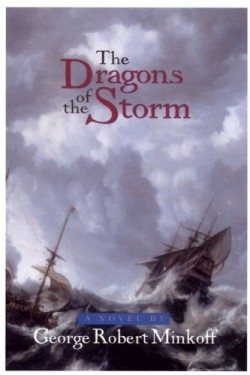The Dragons of the Storm
The Dragons of the Storm is the second book of George Robert Minkoffs projected trilogy about the founding of the Jamestown colony in Virginia in the first decade of the seventeenth century. As in the first volume, The Weight of Smoke, the author intertwines two narratives, one purporting to be the secret diaries of Captain John Smith (he of Pocahontas fame), the other the tale of Sir Francis Drake as told to Smith by Jonas Profit, a member of the Jamestown company who also sailed with Drake a generation earlier.
Where The Weight of Smoke gave more or less equal time to both stories, Francis Drake gets by far the lions share of attention in Dragons of the Storm, a title that plays on the fact that the Spanish for dragon is draque and Drake, a legendary mariner, privateer, and warrior, was more than any other Englishman of the Elizabethan era the fire-breathing nemesis of Spains empire both in the New World and closer to home. His adventures make for often thrilling reading.
At the heart of this book are the two towering exploits which made Francis Drake one of the greatest sailors of all time: his three-year circumnavigation of the globe in 1577-80, and his defeat of the Spanish Armada eight years later. The round-the-world voyage combined discovery with plunder; when he and his weary crew finally dropped anchor in Plymouth, the hold of the Golden Hind contained a hoard of Spanish gold worth more than the rest of the Queens annual income combined. And when Philip II finally launched his long-expected invasion of England, Drake was the guiding light of the defenders; though nominally only second-in-command, he was effectively the admiral of the makeshift, enormously outnumbered fleet that met and vanquished the Spanish in a running battle up the English Channel, thus ensuring Englands survival and sowing the seeds of empire.
Minkoff brings these stories alive, though readers may sometimes doubt that anyone could, some three decades later, recall events in such detail. The author is occasionally constrained by his framing devices, for the diary conceit and the tales-within-tales dont allow for much exposition on subjects ranging from sixteenth century navigation to the curious mix of private commerce and public diplomacy that characterized Tudor England. In addition, his highly poetical language, while colorful and evocative of the period, is a bit impenetrable at times, though not to the degree of the first volume.
Historically accurate, inventive in its language, and filled with exciting and epochal event, The Dragons of the Storm is a worthy successor to The Weight of Smoke.
Reviewed by
Peyton Moss
Disclosure: This article is not an endorsement, but a review. The publisher of this book provided free copies of the book to have their book reviewed by a professional reviewer. No fee was paid by the publisher for this review. Foreword Reviews only recommends books that we love. Foreword Magazine, Inc. is disclosing this in accordance with the Federal Trade Commission’s 16 CFR, Part 255.

